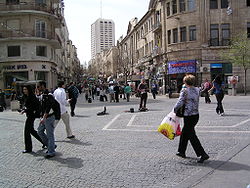Zion Square
| Zion Square | |
|---|---|
| Public square | |
| Kikar Zion | |

Zion Square during the daytime (looking towards Ben Yehuda Street)
|
|
| Location: | Intersection of Jaffa Road, Ben Yehuda Street, Herbert Samuel Street, and Yoel Moshe Salomon Street Jerusalem |
| Coordinates: 31°46′55.2″N 35°13′10.6″E / 31.782000°N 35.219611°ECoordinates: 31°46′55.2″N 35°13′10.6″E / 31.782000°N 35.219611°E | |
Zion Square (Hebrew: כיכר ציון, Kikar Tziyon) is a public square in West Jerusalem, Israel, located at the intersection of Jaffa Road, Ben Yehuda Street, Herbert Samuel Street, and Yoel Moshe Salomon Street.
The square is one of the vertices of the Downtown Triangle commercial district. Since the British Mandate era, Zion Square has been the focal point of the cultural life of downtown Jerusalem. The square is busy day and night with tourists, elderly immigrants, overseas students, local youth, street performers, and religious activists. In recent decades, the square has become a hangout for disaffected and homeless youth.
From the 1930s to 2011, the square was a popular site for mass protests and demonstrations.
The square, originally called Zion Circus, was named for the Zion Cinema (also called Zion Hall), a 400-seat silent movie house which occupied a hut on the site from 1912 to 1920. After the hut collapsed under a heavy snowfall, the cinema was reconstructed as a 600-seat theater for film screenings and live opera performances.
The land on which Zion Square and the Downtown Triangle lies was purchased by the Jewish Colonization Association from the Greek Orthodox Patriarchate, which began selling off some of its holdings in Jerusalem after World War I. Mandate officials developed the field into a triangular district bordered by Jaffa Road, Ben Yehuda Street (constructed by the British in 1922) and King George Street (constructed by the British in 1924). Zion Square was also designed by the British as a roundabout.
The popularity of the films, operas, plays, concerts and lectures presented at the Zion Cinema turned Zion Square into the “center of cultural life in Jerusalem” in the 1920s and 1930s. Movie- and theater-goers gravitated between the cinema and the many cafes and coffee houses in the Downtown Triangle; two of the popular cafes were located in Zion Square itself: the Vienna Cafe and the Europa Cafe.
...
Wikipedia
